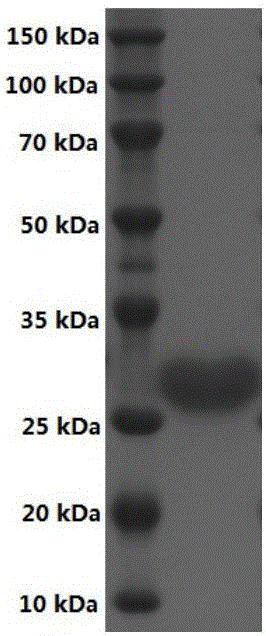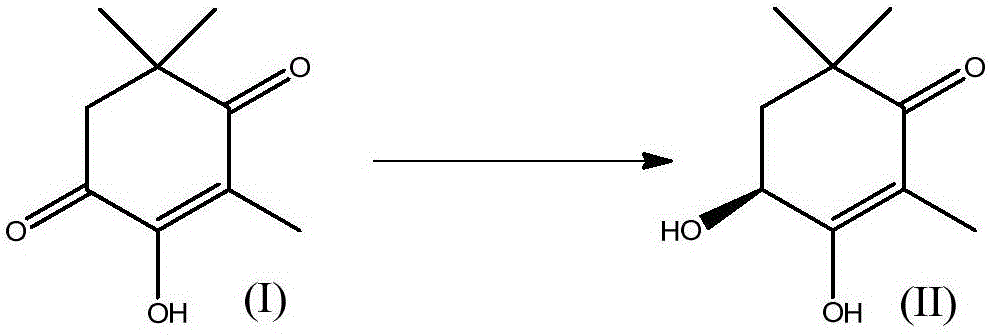Short-chain dehydrogenase and gene thereof, recombinant expression vector, genetically engineered bacterium and application thereof in astaxanthin chiral intermediate synthesis
A technology of short-chain dehydrogenase and genetically engineered bacteria is applied in the application field of short-chain dehydrogenase and its gene, astaxanthin chiral intermediate synthesis, and can solve the limitation of extraction and reuse of crustacean astaxanthin, The yield of astaxanthin has not been improved by a breakthrough, and the research on the secondary metabolism mechanism is not in-depth, so as to achieve the effect of good application and development prospects, easy preparation, and environmental friendliness.
- Summary
- Abstract
- Description
- Claims
- Application Information
AI Technical Summary
Problems solved by technology
Method used
Image
Examples
Embodiment 1
[0039] Example 1: Acquisition of Pseudomonas putida ATCC 12633 short-chain dehydrogenase gene, recombinant plasmid construction and transformation into Escherichia coli
[0040] The whole genome DNA of Pseudomonas putida ATCC 12633 bacterium was extracted with a DNA extraction kit, and the DNA was used as a template, and upstream primers (GCTGA GGATCC ATGGCTAATGCAAAAACCGC) and downstream primers (GCATC CTCGAG TCACCAGACCAAGGGTTCGC) was used as primer for PCR amplification reaction. The amount of each component in the PCR reaction system (total volume 50μL): 5×PrimeSTAR TM 10 μL of HS DNA polymerase buffer, 4 μL of 10 mM dNTP mixture (dATP, dCTP, dGTP and dTTP each 2.5 mM), 1 μL of each upstream primer and downstream primer at a concentration of 50 μM, 1 μL of genomic DNA, PrimeSTAR TM HS DNA polymerase 0.5μL, nucleic acid-free water 32.5μL. The PCR reaction conditions were as follows: pre-denaturation at 98°C for 1min, followed by a temperature cycle of 98°C for 10s, 56°C...
Embodiment 2
[0043] Example 2: Induced expression of recombinant short-chain dehydrogenase
[0044] The engineered bacterium E.coli BL21(DE3) / pET30a-Ppysdr constructed in Example 1 was inoculated into LB liquid medium containing 50 μg / mL kanamycin, cultivated overnight at 37° C., and then inoculated with 1% inoculum (v / v ) was inoculated into 50mL LB medium containing 50μg / mL kanamycin, cultivated at 37°C and 200rpm to the cell concentration OD 600 When the concentration reaches about 0.6, add IPTG with a final concentration of 0.1 mM, induce culture at 26°C for 6 hours, then centrifuge at 8000 rpm at 4°C for 10 minutes to collect the bacterial cells, and store them at -80°C for later use.
Embodiment 3
[0045] Embodiment 3: Separation and purification of recombinant short-chain dehydrogenase
[0046] The thalli cells that embodiment 2 collects are suspended in 10mL Na 2 HPO 4 -NaH 2 PO 4 In buffer solution (100mM, pH 8.0), shake well and then crush under ultrasonic wave (effective time 8min). The broken liquid was centrifuged at 12,000 rpm for 10 min to remove cell debris, and the supernatant (crude enzyme liquid) was collected for subsequent separation and purification of the enzyme. The purification column is Ni-NTA, and the column volume is 5mL. First equilibrate the Ni-NTA column with loading equilibration buffer (20mM sodium phosphate, 500mM NaCl and 20mM imidazole, pH 7.4), and load the crude enzyme at a rate of 5mL / min. solution, eluted with loading equilibration buffer to remove unadsorbed protein, and finally eluted with elution buffer (20mMT sodium phosphate, 500mM NaCl and 500mM imidazole, pH 7.4) to collect the target protein. The enzyme liquid is desalted wi...
PUM
 Login to View More
Login to View More Abstract
Description
Claims
Application Information
 Login to View More
Login to View More - R&D
- Intellectual Property
- Life Sciences
- Materials
- Tech Scout
- Unparalleled Data Quality
- Higher Quality Content
- 60% Fewer Hallucinations
Browse by: Latest US Patents, China's latest patents, Technical Efficacy Thesaurus, Application Domain, Technology Topic, Popular Technical Reports.
© 2025 PatSnap. All rights reserved.Legal|Privacy policy|Modern Slavery Act Transparency Statement|Sitemap|About US| Contact US: help@patsnap.com



